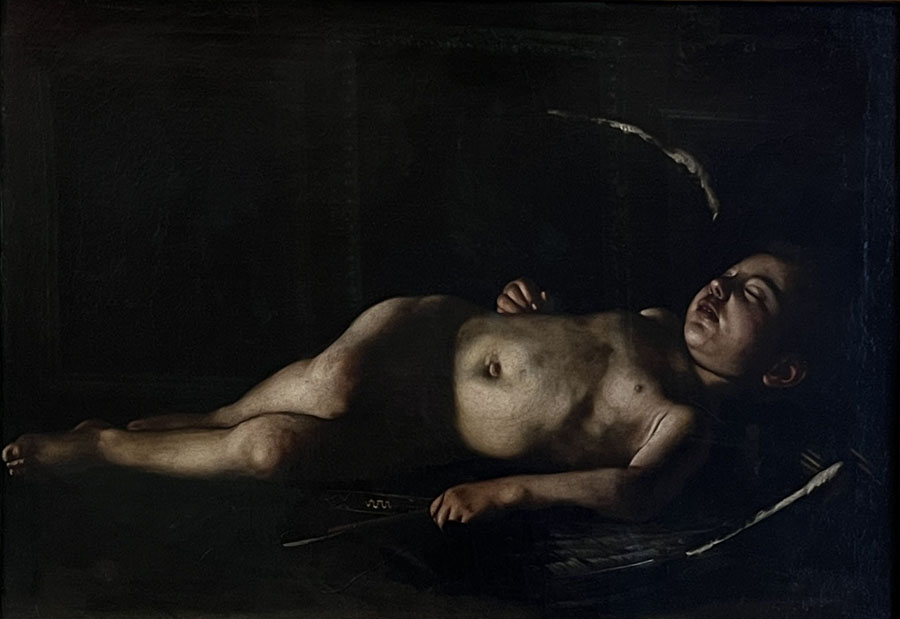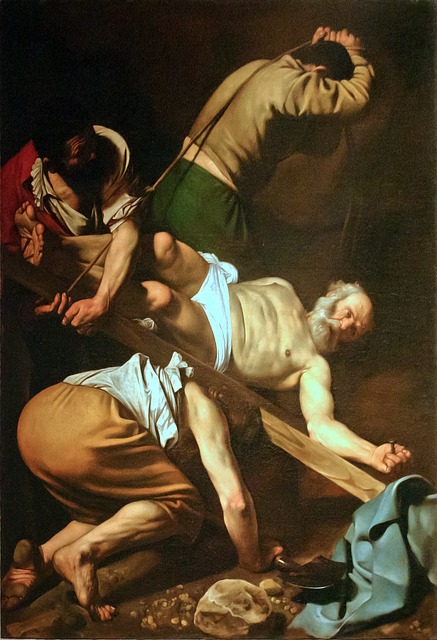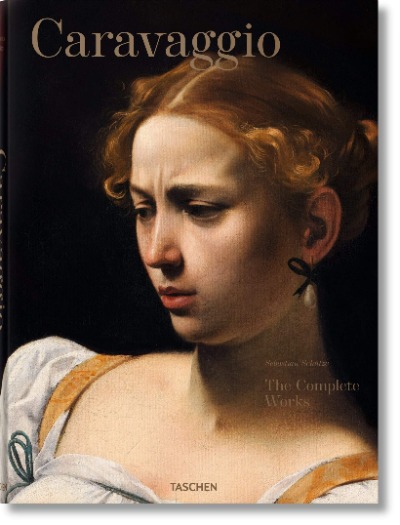Caravaggio, born Michele Angelo Merigi da Caravaggio, is renowned for his mastery in blending lifelike human portrayal with striking lighting effects. The dramatic illumination in his art significantly shaped the Baroque painting style.
Caravaggio would make close physical observations of what he painted. At the same time, he would combine his careful observations with a dramatic use of chiaroscuro. The combination of these two elements came to be known as tenebrism.
Caravaggio, worked rapidly and often depicted dramatic scenes featuring violent struggles, torture and even death. These subjects often befitting from the dramatic techniques he used. He would often forgo making drawings choosing to paint directly onto canvas. He made a profound impact on the new Baroque style. So much so that his influence can be seen in the works of Peter Paul Rubens, Jusepe de Ribera, Gian Lorenzo Bernini, and Rembrandt.
Some Key Facts of Caravaggio the Painter
- The artist was born in 1571 in the city of Milan.
- Caravaggio trained as a painter in Milan before moving to Rome in his twenties.
- He developed a reputation as an artist but also as a violent, touchy and provocative man.
- The painter fled to Naples after a brawl lead to a death sentence for murder.
- He re-established his reputation as an artist in Naples.
- Caravaggio would travel to Malta and Sicily before returning to Naples .
- The painter died in 1610 while on his way from Naples to Rome. It is unknown whether he died from fever, lead poisoning or murder.
Caravaggio’s Influence on Chiaroscuro

Caravaggio’s groundbreaking use of chiaroscuro in painting not only influenced the Baroque period, but also serves as an enduring inspiration for contemporary artists. Interest in his work however fell out of favor when styles and fashions changed. In the 20th century interest in Caravaggio’s work revived once more when the contributions he made to the development of Western art was reevaluated.
The art historian Andre Berne-Joffroy states; “What begins in the work of Caravaggio is, quite simply, modern painting.” Despite the fact that Caravaggio’s work is over 400 years old it is still fresh and relevant to our modern eyes. Caravaggio was a trailblazer of his time.
Read How to Paint your own Chiaroscuro Painting if you want to learn how you can make a painting of your own in a ‘Caravaggesque’ style.
The Crucifixion of Saint Peter

The first time I saw this painting I was shocked that it was in a dark corner of the Cerasi chapel of Santa Maria del Popolo in Rome. If you wanted to see it you had to give a coin so that a light would turn on and allow you to view it for several minutes. Since we were frugal students, my friends and I would look other paintings in the church while keeping an eye out for another tourist to place in a coin so that we could view the piece! 😉
In the “Crucifixion of Saint Peter” Caravaggio does not depict a heroic martyr or Herculean hero in the manner of Michelangelo. Rather he shows us an old man suffering and about to face death. In other words, Caravaggio brings us face to face with reality. It is a hallmark of his work to paint what he observes with the greatest physical accuracy.
Also, notice the dirty feet in the painting. Caravaggio was known to have used beggars as models in his paintings who were not able to afford shoes. Again, we notice an extreme attention to what is real – even when it might not be considered ‘beautiful’ by mainstream society.
The Calling of St. Matthew

Caravaggio’s calling of St. Matthew depicts the moment when Jesus Christ inspired Matthew to follow him and become a disciple. It was created to be displayed on the left wall of the Contarelli chapel in the French church of San Luigi dei Francesi in Rome. Caravaggio’s former employer won the commission but was unable to complete it due to many other commitments. Luckily for Caravaggio he was later given the commission. It would be his first important job.
In line with Caravaggio’s chiaroscuro style all the figures are engulfed in shadow. A beam of light shines from the right side of the canvas highlighting St. Matthew and the seated group.
The Conversion of Saint Paul

This painting resides on the other side of Caravaggio’s “Crucifixion of Saint Peter” in the Cerasi Chapel of Santa Maria del Popolo in Rome. The painting depicts the moment when Saul fell off his horse when he heard a voice say to him “Saul, Saul, why do you persecute Me?” He said, “Who are You, Lord?” The Lord said, “I am Jesus, whom you are persecuting.”
There is great sense of stillness in this piece – it captures a moment in the dramatic story of Paul’s conversion. However, simultaneously there is a great sense of drama in the painting because of Caravaggio’s strong use of Chiaroscuro. In addition, the unusual perspective of the piece brings the viewer to experience the painting in an unusual way by leading our eyes first to the ground where Paul lies. It is a remarkable departure from more traditional compositions in his time period.
His Legacy and Struggles

Caravaggio was an innovator in the world of painting. His whole career, his whole life went against the grain. The artist’s fiery temper could not be quieted as he left behind a trail of misdeeds throughout his life which culminated in murder. Towards the end of his life it would all ultimately catch up with him.
In an attempt to secure a pardon for his sins from the cardinals and the pope he made a painting. It is one that is conventional in subject matter but entirely surprising in every other way. It is David holding up the head of Goliath. The head in this case is Caravaggio’s face. It was as if he was, in the guise of Goliath, turning himself in. The painting seems to read ‘Guilty as charged’.
Unfortunately, the painting would arrive too late for Caravaggio to receive his pardon. He died before the painting even reached the pope and cardinals.
More on Caravaggio
Below are some excellent resources on the work of Caravaggio if you wish to learn more. Also, if you want to make your own ‘Caravaggesque’ painting check out the article ‘How to Paint your own Chiaroscuro painting.’
Caravaggio: The Complete Works
The publisher Taschen releases the best art publications available on the market today. Here is a volume of the complete works of Caravaggio – an must have for all art lovers.
Caravaggio: A Life Sacred and Profane
A wonderful retelling of the life of Caravaggio. You will come to understand what was happening in his life while during each work he painted.








10 thoughts on “Unveiling the Artistry of Caravaggio and His Mastery of Chiaroscuro”
Thanks for sharing this great painter. I like to read about great painters they inspire
me of their talents which i belief God has given them.
Of course! It is a pleasure to share. I am glad you enjoyed the article
תודה רבה על ההדרכה
והמידע החשוב ליצירת בלוג
תודה רבה
רותי
אתה מוזמן רותי! תמיד התענוג שלי לשתף
Are you ‘chip off the old block’ so to speak? You produce a good article. Keep the faith.
Many many thanks Elisabeth for sharing your knowledge and work with us, God Bless you.
Love from Portugal Aida
It is truly my pleasure to get to share the knowledge I have learned! You are very welcome 🙂
Happy Painting!
Elisabeth
I have been told to go and open a WordPress blog account to make web mini sites (web presence) and I am wanting to know if you have better ideas or simply more ideas? Advise for WordPress would be great as well!.
Making a blog is a great idea! Though it also depends on your reasons for wanting to make one. I think it is best to create a blog around something you know a lot about and have a passion for. A great resource for how to create a blog and how to use wordpress can be found here https://createandgo.com/how-to-start-a-blog/
Pingback: Chiaroscuro in Painting- What it is and how to Paint your Own